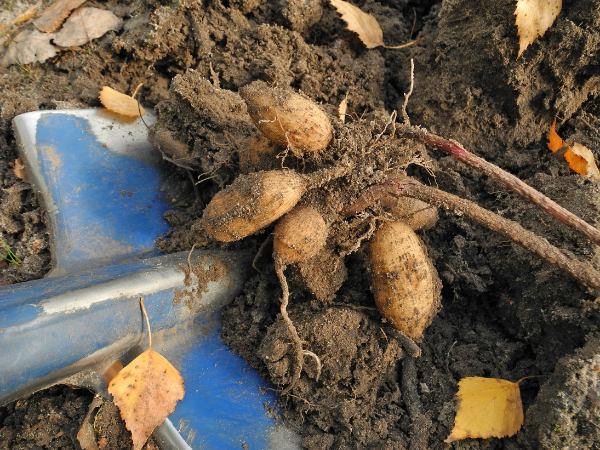
Storing Tender Bulbs
Preserving the Beauty of Tender Bulbs: Your Winter Storage Guide
As the vibrant colours of summer fade and the crisp autumn breeze sets in, it’s time to think about preserving the beauty of your tender bulbs. Tender bulbs are those delightful plants that grace our gardens with their dazzling blooms during the warmer months but need a little extra care to survive the winter. Let’s dive into what tender bulbs are, which ones require winter care, and how to store them to ensure a spectacular garden next spring.
What Are Tender Bulbs?
Tender bulbs are a diverse group of plants that grow from underground storage structures. Unlike hardy bulbs, which can endure harsh winter conditions, tender bulbs are more delicate and susceptible to frost damage. They include favourites like dahlias, gladiolus, caladiums, cannas, and alocasias, to name a few. These beauties need special attention to make it through the winter unscathed.

Which Tender Bulbs Need Winter Care?
While not all tender bulbs require winter protection, it’s essential to know which ones do to avoid disappointment in the spring. Here are some common tender bulbs that benefit from winter care:
- Dahlias: These showstoppers produce an array of stunning blooms but are frost-sensitive.
- Gladiolus: Known for their elegant spikes of flowers, gladiolus bulbs need protection from freezing temperatures.
- Caladiums: With their colourful, heart-shaped leaves, caladiums should be sheltered during winter.
- Cannas: These tropical-looking plants add drama to any garden but need warmth during the cold months.
- Alocasias (Elephant Ears): These tropical beauties feature large, elephant ear-like leaves and should be stored indoors during the winter in colder climates.
How to Prepare Tender Bulbs for Winter Storage
1. Dahlias:
- Cutting Back: After the first frost, cut the dahlia stems down to about 4-6 inches above the soil level.
- Drying: Carefully dig up the tubers, rinse off excess soil, and let them air dry for a few days.
- Storing: Place the dried tubers in a cardboard box or crate filled with dry peat moss or vermiculite, ensuring they don’t touch each other, and store in a cool, dry place.

2. Gladiolus:
- Cutting Back: After the first frost, cut the entire gladiolus stem down to ground level.
- Drying: Lift the corms (bulb-like structures) and allow them to dry in a well-ventilated area for several weeks.
- Storing: Store the corms in a mesh bag or crate filled with dry sawdust in a cool, dry location.

3. Caladiums:
- Cutting Back: Once the leaves start to wither and die back, cut the stems down to ground level.
- Drying: Gently lift the bulbs, brush off excess soil, and let them air dry for a few days.
- Storing: Store caladium bulbs in a cardboard box with peat moss, ensuring they’re not touching, and place in a warm, dry spot.

4. Canna Lily:
- Cutting Back: After the first frost, cut the canna stems down to a few inches above the ground.
- Drying: Lift the rhizomes, remove loose soil, and air dry them for a few days.
- Storing: Store canna rhizomes in a crate or box filled with peat moss, keeping them in a cool, dry location.

5. Alocasias (Elephant Ear):
- Cutting Back: As the weather cools and the leaves start to wither, trim the foliage back to ground level.
- Drying: Carefully dig up the Alocasia bulbs, shake off excess soil, and let them air dry indoors for about a week.
- Storing: Store the dried Elephant Ear bulbs in a cardboard box or crate filled with dry peat moss or vermiculite in a cool, dry location. Ensure that the bulbs don’t touch each other during storage.

Storing Tender Bulbs Over Winter
Now, let’s ensure your tender bulbs are snug and safe for the winter:
- Choose a Storage Container: Use crates, cardboard boxes, or mesh bags to store your bulbs. Make sure the containers have good airflow.
- Add Insulation: Layer your bulbs with peat moss, vermiculite, or sawdust to insulate them against temperature fluctuations.
- Labelling: Don’t forget to label your storage containers with the bulb type and colour for easy identification come spring.
- Store in a Cool, Dry Place: Find a dark, cool (but above-freezing) spot, like a basement or garage, to store your bulbs until the threat of frost has passed.

With these winter storage tips, you’ll be well-prepared to nurture your tender bulbs through the chilly months, ensuring a vibrant and colourful garden once again. Imagine the beauty that will grace your garden beds and containers next spring as these lovely bulbs awaken from their winter slumber!
Remember, each tender bulb is a promise of the spring’s beauty. By giving them the care they need during the winter, you’re ensuring a breathtaking garden that will delight the senses and bring joy to your outdoor space.
